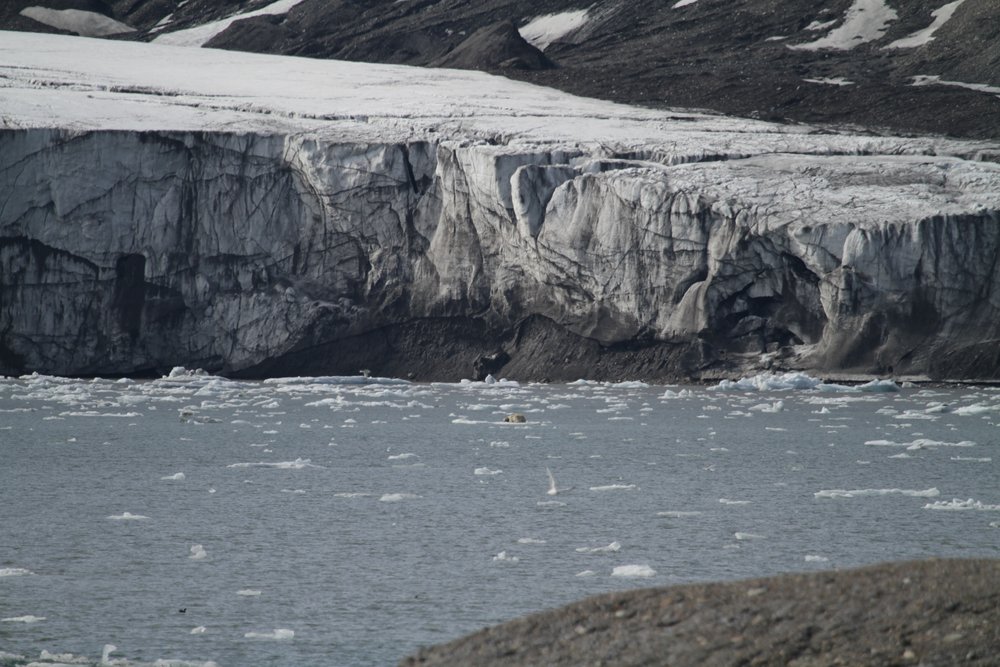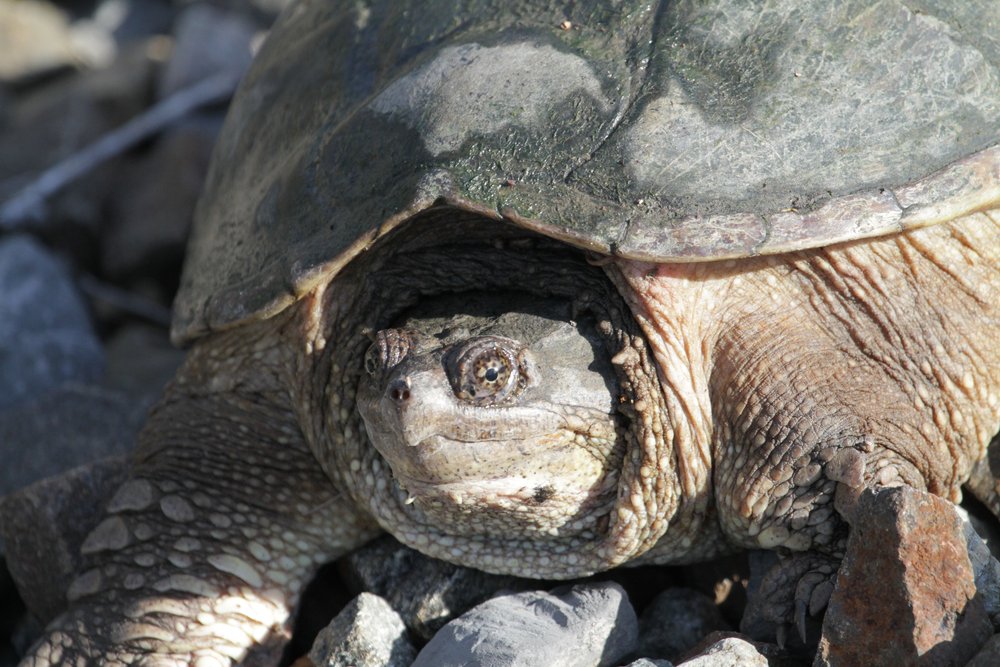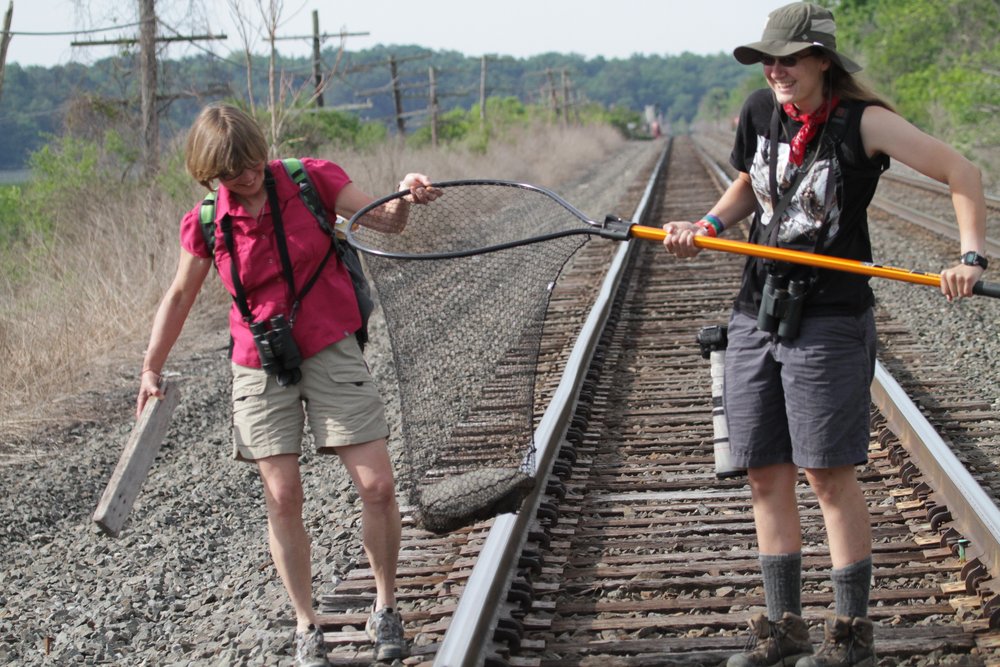PB

We had sailed into a beautiful fjord. Our three guides, Sarah Red, Sarah Blue and Therese went ashore to mark off a safe area. The scan and set-up was taking longer than usual. We stood on deck and strained toward the shore to know what was happening. The radios crackled. And then word came back: a bear was there, floating on a small iceberg. We could say those two words: Polar Bear.

We had sailed into a beautiful fjord. Our three guides, Sarah Red, Sarah Blue and Therese went ashore to mark off a safe area. The scan and set-up was taking longer than usual. We stood on deck and strained toward the shore to know what was happening. The radios crackled. And then word came back: a bear was there, floating on a small iceberg. We could say those two words: Polar Bear.

Then, without fanfare, the bear slipped off of its resting spot and swam off. We returned the zodiacs and the safety of the ship. A half hour later, the bear ambled onto shore. It swung its legs in a casual manner, but its strength and speed, even at a distance was obvious. The bear was off-white, smudged by dirt, not fat and not thin. From the distance of the ship I couldn’t see details of eyes or teeth, couldn’t smell the fur of the big bear. I only could see big shaggy feet, a lumbering gait.
I had been thinking that the safety of the trip was excessive—so much precaution against so few bears (there are approximately 3,500 on Spitsbergen). But once I saw this bear I realized how unexpected it was, and how fast it moved. Since the early 70s, when the Norwegian government required all traveling on Svalbard to carry a gun, only five people have been killed. That’s an impressive record. So my feeling caged in by the limited safety zones was the bear’s freedom. That seemed a fair trade off.
Nansen in his expedition north on the Fram met many bears. And he never hesitated to pull out his gun and shoot—a polar bear provided a lot of food for his men, and the fresh meat was important in keeping scurvy away. But his shooting is often dreadful to read—there are sloppy and slow deaths, and then there is a moment when he kills a mother with two cubs. He shoots the mother first, then describes in oddly loving detail the young sniffing and pushing at their mother in despair. He shoots them as well. Nansen finds the breast of the cubs a delicacy. The bear moving before me, however, is protected. No one is allowed to shoot a bear, except in self defense (and then an investigation ensues to ensure the danger was real).

Snapping Turtle Tradition

I prepared for snapping turtle week by buying a fishing net. As I left Gander Mountain someone called to me: “butterflies?”—those would be some butterflies!
“Nope, Snapping turtles,” I called back, cheerful.
He rolled his eyes.

I prepared for snapping turtle week by buying a fishing net. As I left Gander Mountain someone called to me: “butterflies?”—those would be some butterflies!
“Nope, Snapping turtles,” I called back, cheerful.
He rolled his eyes.
 my finest rescue techniqueBecause snappers travel to lay their eggs, they cross roads and railroad tracks—and often are crushed. Already I had clumsily shoved a turtle across a road, the turtle snapping, four or five of us offering suggestions, stopping or slowing cars, and from time to time screaming in surprise when the turtle lunged with a snap. The net was the solution to all of my turtle rescuing problems.
my finest rescue techniqueBecause snappers travel to lay their eggs, they cross roads and railroad tracks—and often are crushed. Already I had clumsily shoved a turtle across a road, the turtle snapping, four or five of us offering suggestions, stopping or slowing cars, and from time to time screaming in surprise when the turtle lunged with a snap. The net was the solution to all of my turtle rescuing problems.
Last year, I stumbled on the maternity ward of snappers along the train tracks that slice the North Tivoli Bay from the main artery of the Hudson River. There, in the black gravel laid as foundation for the tracks the snapping turtles can easily dig, then the sun warms the eggs beautifully. On June 6 of last year, I saw dozens of turtles digging, and rescued one caught between the rails. The next day, dozens of turtles lay crushed, mangled by the trains barreling north and south. This year, I was going to save as many turtles as possible.


Further up the track it was a regular egg laying fest. Over twenty nests had been dug and raided—no doubt by raccoons. Shreds of the eggs littered the disturbed holes, the white so white against the black soil. But over a dozen lady snappers were still in holes, quietly laying their round, white eggs. Three had gathered near to each other, hind ends burrowed deep in the soil. When we returned half an hour later, one was gone—and her nest already empty. How quickly the thief works!
And yet--though the raccoon was hard at work, we saw no turtles crushed by the steel wheels of the train. This, a small relief.
We stopped for tea and sticky buns brought by Kate from the Tivoli Bakery—for any tradition to be a success, good food is essential—and watched barn swallows wing in and out under the underpass.

Does saving two snapping turtles make a difference? Maybe, but maybe not. It is comforting but naïve to think that every little bit helps—because in the face of our environmental problems this doesn’t even register. What matters, though, is that saving these turtles is what I can do, it’s what I do. It’s one of my traditions.
Baby Beaver



In the distance, I saw the tell-tale V of a beaver plowing through the water. In 1840, the beaver was a rare animal in New York State. Trapping had all but wiped out this large rodent, whose pelts were used for hats and coats. When trapping was finally prohibited in 1895, some claim there were but 10 left in the State. In the North Tivoli Bay, it is hard to believe this desperate history: I always see a beaver. Or rather, I hear a slap of a broad tail, signaling danger before the beaver dives below the surface.
I guessed it was lost. Across the channel rested a stick pile, a beaver lodge. I moved my boat to the middle of the channel thinking the little beaver might swim to me once again and this would get it closer to home. It did. And I had the foresight to turn on the video in my pocket camera. And sure enough, after it rounded the stern of my boat, the baby beaver swam off toward the lodge. Watch the video here.
Full of optimism, I paddled home.